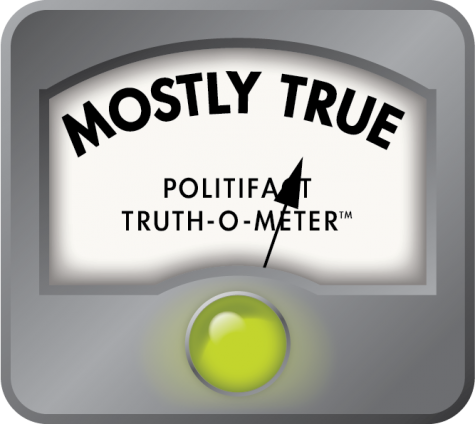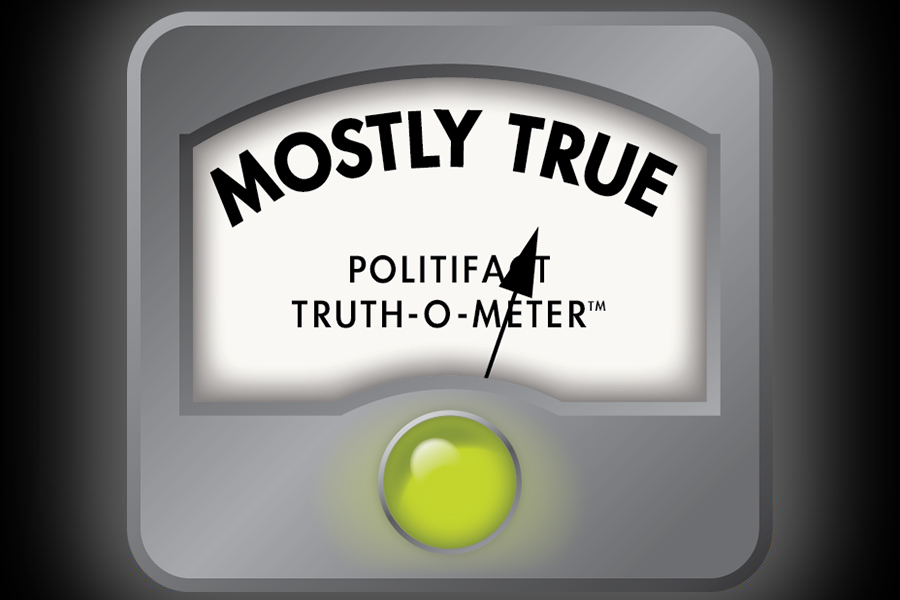Fact Check | Farm income was up going into planting season, but not as high as president says
President Trump claimed that net farm income has increased 50 percent since he has taken office. What he didn’t say was that federal aid accounts for a large portion of that increase.
May 22, 2020
PolitiFact Iowa is a project of The Daily Iowan’s Ethics & Politics Initiative and PolitiFact to help you find the truth in politics.
Edited by Lyle Muller and Marissa Payne
If your time is short:
- President Trump claimed at a Jan. 30 Iowa campaign rally that net farm income has increased 50 percent since he has taken office.
- With multiple farm relief packages making their way through Congress, income is on the minds of farmers as they begin harvesting fields.
- While net farm income increased 50 percent from 2016 through 2019, federal aid accounts for a large majority of that income.
President Trump claimed at a Jan. 30 Des Moines campaign rally that farm net income has increased 50 percent since he has taken office. The claim remains noteworthy because income is on the minds of farmers completing their planting season and the coronavirus pandemic has led Congress to allocate billions of dollars in federal aid, with additional legislation pending.
“You suffered a lot with people that were stupid,” Trump said at the rally. “Under three years of my administration, net farm income has already gone up nearly 50 percent and will now be rising even faster.”
Whether that income has gone up 50 percent, however, requires some explanation.
Alejandro Plastina, an assistant professor of economics at Iowa State University, said net income has increased, but mostly because a large portion of it came from federal aid to farmers in 2017 through 2019 to counter the effects of a United States trade dispute with China.
Plastina said removing direct government farm program payments would show 2016 through 2019 net income, which accounts for total yields and additional revenue farmers collect, increasing 42 percent and net cash income that covers only total crop yields and livestock increasing 17 percent.
Why the different net income figures, and why are they different from Trump’s? Because the U.S. Department of Agriculture calculates net farm income by taking into account farmers’ inventories, total yield revenues, and machinery and other costs applied to the production process that offset income. For example, the net cash income that only encompasses total yields increased 25 percent with direct farm program payments from $95.6 billion in 2016 to $120 billion in 2019, according USDA Economic Research Service data.
According to that USDA data, farm net income increased 50 percent from 2016, the last full year Barack Obama was president, through 2019, from $62.3 billion to $93.6 billion. The Daily Iowan reached out to the USDA for data on how much direct farm payments account for the total of farm net income since Trump has been in office, but only received the following statement via email attributed to a USDA spokesperson:
“From 2016 to 2020, net farm income has increased 55%.”
In 2015, federal aid to farmers accounted for an average of 13 percent of their overall net income. In 2016, that number increased to about 21 percent. In 2017, federal aid accounted for about 15 percent of overall net farm income, in 2018 it accounted for about 16 percent, and in 2019 it accounted for 25 percent of farmers’ net farm income. We calculated these figures using two data tables from the USDA — one listing the federal aid payments and other listing net income trends.
The USDA forecasts that federal aid could account for about 15 percent of overall net farm income in 2020, based on data as of February, which does not include some COVID-19-related relief packages. The next 2020 income and federal aid forecast is to be released in September.
In 2013 when Obama was president, net farm income reached a record high of $124 billion, but Plastina said that can be attributed to farm fields being more productive.
On April 17, Trump announced a $19 billion federal aid package for the agriculture sector that includes $16 billion in direct payments to farmers. This additional income is not factored into the USDA’s 2020 net income forecast. More agriculture relief bills are on the horizon, including a bipartisan House bill that would lift the Commodity Credit Corporation’s annual borrowing cap to $68 billion — an amount adjusted to catch up with inflation, according to the American Farm Bureau.
If you look at net income year-by-year, the increase from 2017 through 2019, when Trump was in office, was 25 percent. When factoring in 2015 and 2016, during the Obama Administration, the increase in farm net income was 15 percent over the five-year period.
According to the USDA 2020 Farm Income Forecast, net farm income is projected to increase $3.1 billion, or about 3 percent, from 2019 through 2020. In inflation adjusted dollars, that expected increase would be $1.4 billion, or about 1 percent, from 2019 through 2020. Net cash income is expected to decrease by 9 percent from 2019 through 2020, the forecast showed.
According to the forecast, the anticipated net cash income decline could be attributed to $14.7 billion in cash receipts from crop sales in 2019 and $0.5 billion in sales in 2020.
Tom Vilsack, former Iowa governor and former U.S. Secretary of Agriculture, countered Trump’s claim on net farm income on Twitter by noting that farm bankruptcies in the U.S. had increased 20 percent.
Vilsack wrote: “The reality is that when @JoeBiden was VP and Barack Obama was president farmers had the highest income in the history of the United States of America. Today we’ve seen a 20% increase in farm bankruptcy.”
According to the American Farm Bureau, farm bankruptcies in the U.S. increased 20 percent from 2018 to 2019, even with direct farm payment programs. In 2019, 595 family farms nationally declared Chapter 12 bankruptcy, up by 100 from the previous year and the highest since 2011, according to the American Farm Bureau.
According to the bureau report, an increase in bankruptcy filings was anticipated because of uncertainty on the trade front, record farm debt, and recent changes to the 2019 Family Farmer Relief Act, which increased the debt ceiling to $10 million to broaden the definition of what it means to be a family farmer.

Our ruling
Trump said net farm income has increased 50 percent since he has taken office. Data from the USDA shows that while net income has increased by 50 percent, but federal aid to farmers accounts for a large portion of that increase and the aid was not the usual kind of federal assistance farmers receive. Rather, it was given because of a Trump Administration decision to take on a trade war with China. We rated Trump’s claim as mostly true.
Sources:
Phone interview with Iowa State University Assistant Professor of economics Alejandro Platsina
Email statement from USDA spokesperson
USDA Economic Research Service: 2020 farm sector income forecast
USDA Economic Research Service: U.S. farm sector financial indicators 2013-2020
USDA Economic Research Service: Government payments by program
American Farm Bureau: Reviewing the Commodity Credit Corporation’s Borrowing Authority
American Farm Bureau: The Verdict Is In: Farm Bankruptcies Up in 2019















